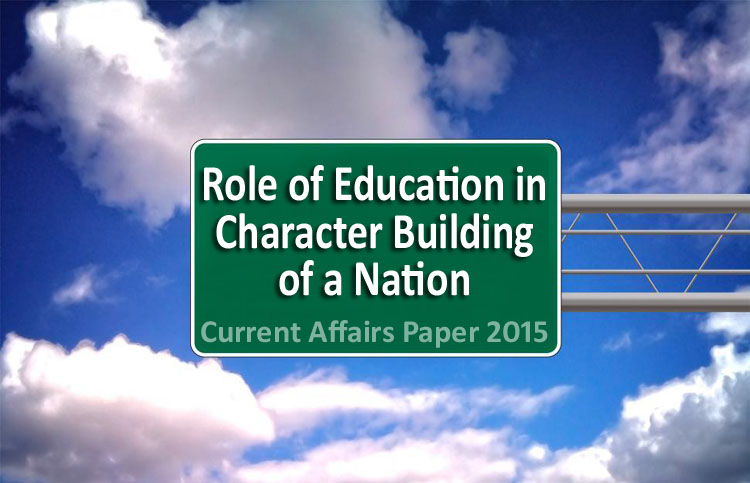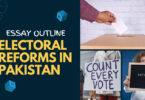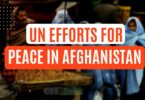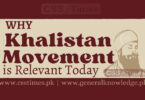(CSS Current Affairs Paper 2015)
Question: What is the role of education in character building of a nation? Highlight major pitfalls in Pakistan’s educational systems.
Introduction
Education, if looked at beyond its conventional boundaries, forms the very essence of all our actions. What we do is what we know and have learned, either through instructions or through observation and assimilation. When we are not making an effort to learn, our mind is always processing new information or trying to analyze the similarities as well as the tiny nuances within the context which makes the topic stand out or seem different. If that is the case then the mind definitely holds the potential to learn more, however, it is us who stop ourselves from expanding the horizons of our knowledge with self-doubt or other social, emotional, or economic constraints.
1. Social Importance
Education, has a great social importance specially in the modern, complex industrialised societies. Philosophers of all periods, beginning with ancient stages, devoted to it a great deal of attention. The main social objective of education is to complete the socialization process. The family gets the child, but the modern family tends to leave much undone in the socialisation process. The school and other institutions have come into being in place of family to complete the socialization process. Now, the people fell that it is “the school’s business to train the whole child even to the extent of teaching him honesty, fair play, consideration for others and a sense of right and wrong”. The school devotes much of its time and energy to the matter such as co-operation, good citizenship, doing one’s duty and upholding the law.
2. Formation of Social Personality
Individual must have personalities shaped or fashioned in ways that fit into the culture. Education, everywhere has the function of the formation of social personalities. Education helps in transmitting culture through proper molding of social personalities. In this way, it contributes to the integration, to survive and to reproduce themselves.
3. Reformation of Attitudes
Education aims at the reformation of attitudes wrongly developed by children already. For various reasons the child may have absorbed a host of attitudes, beliefs and disbeliefs, loyalties and prejudices, jealously and hatred etc. these are to be reformed. It is the function of education to see that unfounded beliefs, illogical prejudices and unreasoned loyalties are removed from the child’s mind, though the school has its own limitations in this regard, it is expected to continue its efforts in reforming the attitudes of the child.
4. Fosters Participant Democracy
Education fosters participant democracy. Participant democracy in any large and complex society depends on literacy. Literacy allows full participation of the people in democratic processes and effective voting. Literacy is a product of education. Educational system has this economic as well as political significance. Education Imparts values:
The curriculum of the school, its extracurricular activities and the informal relationships amongst students and teacher communicate social skills and values. Through various activities a school imparts values such as co-operation or atmospheric, obedience, fair play. This is also done through curriculum that is through lessons in history literature etc.
5. Education Acts as an Integrative Force
Education acts as integrative force in society by communicating value, that unite different sections of society. The family may fail to provide the child the essential knowledge of the social skills and values of the wider society. The school or the educational institutions can help the child to learn new skills and learn to interact with people of different social backgrounds.
MAJOR PITFALLS IN PAKISTAN’S EDUCATIONAL SYSTEMS
The educational system of the country is based on different mediums which divides the students in two segments. Mostly private schools are English medium while the Government schools are Urdu medium. Regional differences are also a major cause for a poor educational system in Pakistan.
1. Gender Discrimination
Gender discrimination is very common in Pakistan. People are very conservative and they don’t want their girls to go to school and get education. Due to this, the ratio of boys and girls in primary schools is 10:4.
In Human Development Report Pakistan is placed at 136th position for having just 49.9% educated population. In addition to that, Pakistan is ranked at 113th out of 120 registered UN members according to the research conducted by UNESCO et al. Some of the very basic flaws of the education system in Pakistan contribute to the economic, ethnic and sociopolitical crisis within the country.
2. Quality of Education
Moreover, the quality of education in most of the public schools and colleges is well below par; the teachers in government schools are not well trained. People who do not get job in any other sector, they try their luck in educational system. They are not professionally trained teachers so they are unable to train a nation. Quality of teaching needs special attention in rural areas where the teachers lack in all departments.
Poverty is another factor that prohibits the parents to send their children to private school where the quality of education is high. Poor people get their children admitted to Government schools. The teachers in Government
schools are not professionally trained. They even don’t take lectures and waste the precious time of the students.
3. The Allocation of Funds for Education Sector
The allocation of funds for education sector by the Government of Pakistan are very low; only 2% of the total GDP. Government should increase this rate to improve the quality of educational system.
The educational system of Pakistan is based on unequal lines. Medium of education is different in both, public and private sector. This creates a sort of disparity among people, dividing them into two segments.
4. Regional Disparity
Regional disparity is also a major cause. The schools in Baluchistan (The Largest Province of Pakistan By Area) are not that much groomed as that of Punjab (The Largest Province of Pakistan By Population). In FATA, the literacy rate is deplorable constituting 29.5% in males and 3% in females.
5. Gender Discrimination
The ratio of gender discrimination is a cause which is projecting the primary school ratio of boys & girls which is 10:4 respectively. For the last few years there has been an increase in the growth of private schools. That not only harms the quality of education but creates a gap among haves and has not.
6. Lack of Technical Education
The lack of technical education is a biggest flaw in the educational policy that has never been focused before. Therefore, less technical people mean less.
7. Untrained Teachers
The teachers in government schools are not well trained. People who do not get job in any other sector, they try their luck in educational system. They are not professionally trained teachers so they are unable to train a nation.








I Really like your post. Thanks for sharing.